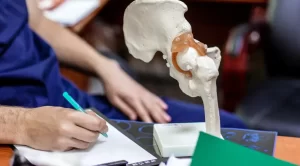After an anterior hip replacement, many patients wonder about the return to normal activities, particularly whether they can safely climb stairs. In this article, we will explore when and how you can safely climb stairs after your procedure, offering expert insights and practical advice to ensure a smooth recovery process.
Understanding the Role of Mobility in Hip Replacement Recovery
Mobility plays a critical role in the recovery process following anterior hip replacement surgery, impacting everything from pain management to the restoration of daily function. After surgery, the body is in a delicate healing state, and regaining movement is one of the most important milestones in recovery. Early mobility exercises are essential not only for preventing complications like blood clots and muscle atrophy but also for stimulating the body’s natural healing processes. Moving the joint, even at a gentle pace, encourages blood flow, which aids in the delivery of nutrients to the healing tissues.
However, restoring mobility is not simply about getting up and walking; it involves carefully progressing through different stages of movement, gradually increasing range of motion, and strengthening the muscles surrounding the hip. One of the first goals is to regain basic movements like sitting, standing, and walking, all of which help re-establish normal function. As recovery continues, more complex movements, such as bending, squatting, and climbing stairs, are introduced to challenge the joint while ensuring it remains stable. This progressive approach to mobility ensures the hip joint is being used appropriately and avoids stressing the new joint too soon. It’s essential to strike the right balance between activity and rest during this phase, as overexertion can lead to complications, while underuse can delay recovery. Proper guidance from physical therapy and ongoing support from healthcare providers help patients navigate this critical phase of their recovery successfully.
Can You Climb Stairs Right After Surgery?
Climbing stairs immediately after anterior hip replacement surgery is generally not recommended due to the body’s need to heal and adjust to the new joint. In the first few days to weeks following surgery, the focus is primarily on minimizing pain, reducing swelling, and gradually regaining basic mobility. Attempting to climb stairs too soon can place unnecessary strain on the healing hip and increase the risk of complications such as dislocation or muscle strain.
Initial Recovery Phase (First 1-2 Weeks)
During the initial recovery phase, patients are typically advised to avoid stair climbing altogether. At this stage, the priority is resting and using assistive devices like crutches or walkers to help with mobility. The muscles surrounding the hip are still healing, and putting too much pressure on the new joint can hinder the recovery process. Patients may be instructed to keep the affected leg elevated to reduce swelling and allow proper healing of the surgical site.
When Is It Safe to Start?
Once patients have regained enough strength, mobility, and stability in their hip, stair climbing can be introduced, often with assistance and guidance from a physical therapist. Typically, this begins after 2-3 weeks, but it can vary depending on the patient’s healing progress and physical condition. It’s essential to approach stair climbing gradually, ensuring that the hip joint is stable and the surrounding muscles are strong enough to support the movement without risking further injury.
How Anterior Hip Replacement Affects Stair Climbing
Anterior hip replacement surgery offers several advantages over traditional approaches, particularly when it comes to mobility post-surgery. The anterior approach involves accessing the hip joint from the front of the body, which avoids cutting through muscles and tendons. This generally leads to less muscle trauma and faster recovery in terms of range of motion. However, stair climbing after anterior hip replacement still presents challenges, as the body needs time to adjust to the new joint and rebuild strength around it.
The key issue with stair climbing after anterior hip replacement lies in the need to ensure proper alignment and movement mechanics. Although the anterior approach is less invasive, it still requires the body to adjust to the new joint’s mechanics and the healing process of the surrounding muscles. The hip flexors, which are vital for stair climbing, often need rehabilitation to regain their full function. These muscles may feel tight or weak in the early stages of recovery, making stair climbing difficult. Additionally, while the surgical site may heal relatively quickly, the surrounding muscles and soft tissues need time to regain strength and flexibility.
Patients often need to retrain their bodies to climb stairs correctly, using a method that involves leading with the unaffected leg first and following with the surgical leg. This ensures that pressure is gradually placed on the healing hip, helping to prevent stress on the new joint while supporting the body’s natural healing process.
Tips and Strategies for Safe Stair Climbing During Recovery
Stair climbing is an important milestone in the recovery process after anterior hip replacement surgery, but it requires careful attention to technique and timing. As you regain strength and stability in the hip, it’s essential to approach stair climbing gradually to avoid strain and ensure proper healing. While it may be tempting to return to normal activities quickly, being mindful of your movement patterns is key to preventing complications and enhancing recovery.
- Use the “Good Leg First” Approach: When climbing stairs, always step with the unaffected leg first. This reduces the strain on the healing hip and allows the stronger leg to bear the initial weight.
- Keep a Handrail or Support Nearby: Use handrails or a stable object to help you maintain balance. This extra support can alleviate the pressure on your leg and provide stability as you navigate stairs.
- Take One Step at a Time: Avoid rushing. Take one step at a time and focus on controlled movements. This minimizes the chance of missteps or instability.
- Practice on Low Stairs First: Before tackling regular staircases, practice on low steps or stairs with lower risers to build confidence and strength gradually.
- Be Mindful of Pain: Listen to your body. If stair climbing causes pain or discomfort, stop and consult your healthcare provider or physical therapist. Pushing through pain could delay recovery or cause further damage.
- Wear Supportive Footwear: Opt for comfortable, non-slip shoes with good arch support to ensure stability as you climb stairs. Avoid wearing socks or slippery shoes that may increase the risk of falling.
Conclusion
Climbing stairs after an anterior hip replacement is an important step in regaining independence and mobility. With the right guidance, timing, and physical therapy, most patients can safely return to stair climbing during their recovery process. By following proper techniques and gradually strengthening the muscles around the hip, you can ensure a smooth transition back to daily activities. If you’re recovering from hip surgery and need personalized guidance on stair climbing or any other aspect of your recovery, visit The Hip and Pelvis Institute or call (415) 530-5330 to schedule an appointment. We’re here to help you every step of the way.









